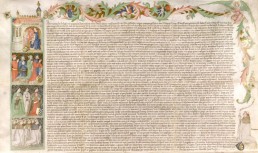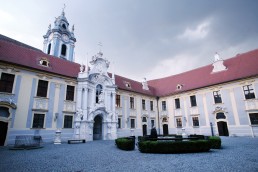Discovery of
the Precious
The History of Dürnstein Abbey
The history of Dürnstein Abbey is a very eventful one. It begins in 1372 with the dedication of a Mary Chapel. The redesign of the exhibition rooms in the winter of 2018–2019 opened up the next key chapter in the history of the Abbey …
Foundation
In 1372, a chapel was built in Dürnstein and dedicated to Mary, mother of God, St Andrew, St Laurence and all saints. The widow Elisabeth von Kuenring had bequeathed her estate for this purpose. In 1410, her heir Otto von Maissau founded a monastery around the chapel and brought Augustinian Canons from Wittingau in Bohemia (present-day Třeboň, Czech Republic) to Dürnstein. In the fifteenth century, the canons built the church, priory and cloister. The structure of the medieval priory was also key to the renovations undertaken in the baroque period.

Baroque Renovations
In the late seventeenth century, the Provosts – the title given by the Augustinian Canons to the head of the monastic community – renovated the Abbey complex in the baroque style for the first time while retaining the gothic structure. When Hieronymus Übelbacher was elected Provost in 1710, by his own account, the church and priory were in poor condition. He first of all renovated the priory building where the canons lived. Then reconstruction began on the church, cloister and tower, and the south wing with its great church portal was completely rebuilt. In this period the irregularly shaped Abbey courtyard was also closed to create an imposing quadrangle.
Provost Hieronymus Übelbacher was a learned man with a doctorate in biblical studies. With his extensive education, his interest in art and science and his prudent financial management, he shaped how Dürnstein Abbey looks today. He provided the builders and artists with the theological agenda of the buildings and their decoration, and he had very specific ideas about how the project should be carried out. The master builder was Joseph Munggenast. Jakob Prandtauer, an architect from St Pölten, designed the entrance portal and courtyard, while Vienna-based Matthias Steinl designed the church portal and interior and the lower floor of the tower.

The Abbey Church, which has also been the parish church since 1745, is dedicated to the Virgin Mary’s assumption into Heaven. Parts of the original gothic church were reused in the renovations of 1721–1724. Many artists and craftsmen participated in the architectural and interior decoration of the church. Santino Bussi, Antonio Beduzzi and Carl Haringer are among those named in the Provost’s notes. The sculptures were designed by Johann Schmidt, father of the famous Austrian baroque painter Martin Johann Schmidt (‘Kremser Schmidt’). ‘Kremser Schmidt’ himself also carried out work at the Abbey. The side chapels contain two of his paintings. One unique feature is the fully rotatable tabernacle of the high altar, in the form of a globe decorated with 44 scenes from the life of Jesus. The Abbey organ was built in 1724. It is a South German baroque organ with over 800 pipes, and it is still in its original condition.
Dissolution and a New Start
As part of the numerous reforms under Emperor Joseph II, Dürnstein Abbey was also dissolved in 1788. This brought monastic life in the town to an end.
The parish and buildings were transferred to the Augustinian Canons at Herzogenburg, who continue to administer them to this day.
For 200 years, only the most urgent maintenance could be carried out on the priory. Only in the 1980s was the building thoroughly restored, both externally and, in part, internally (e.g. cloister, crypt). This was a joint initiative between Herzogenburg Abbey, the State of Lower Austria, the Diocese of St Pölten, the Austrian Federal Ministry of Science, the town of Dürnstein and numerous private donors.
To preserve the structure of the building, in recent years more and more parts of the Abbey have been renovated: for example, the two Art Society Rooms, which can now be hired for meetings and seminars. Twelve rental apartments were also sympathetically integrated into the existing building.
Redevelopment work in the winter of 2018–2019 allowed the creation of the new permanent exhibition Discovery of the Precious, which also includes some areas not previously accessible to the public. This was possible due to the financial support of Herzogenburg Abbey, the State of Lower Austria and the Friends’ Association of Dürnstein Abbey.
All this makes Dürnstein Abbey an attractive tourist destination today. The Abbey also houses the community hall, a primary school, the rental apartments and the event spaces.
